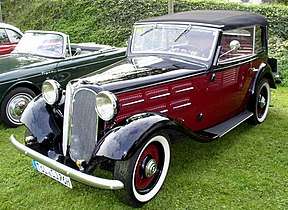BMW M78
The BMW M78 is an overhead valve straight-six petrol engine which was produced from 1933 to 1950.[1] It is the first straight-6 automobile engine produced by BMW, an engine layout which been a key feature of the brand for many years since.[2]
| BMW M78 | |
|---|---|
| Overview | |
| Production | 1933–1950 |
| Layout | |
| Configuration | Straight-six engine |
| Displacement | 1.2–2.0 L (73–122 cu in) |
| Block material | Iron |
| Head material | Iron |
| Valvetrain | OHV |
| Combustion | |
| Fuel type | Petrol |
| Chronology | |
| Predecessor | None |
| Successor | BMW M337 |

The M78 was launched in the 1933 BMW 303.[3] In 1936, the higher performance BMW M328 straight-six engine began to be produced alongside the M78.
Design
The M78 has an iron block and cylinder head.[3] It was designed by Rudolf Schleicher.[3](p25)[4]
Initial versions of the M78 had the same bore and stroke as the four-cylinder engine from the BMW 3/20. Later on, the bore spacing was increased to allow for an increase in bore and to provide for more crankshaft bearings.
In 1952, the BMW M337 engine was introduced as the replacement to the M78. Compared with the M78, the M337 has a revised cylinder head, a new inlet manifold and a reinforced crankshaft with bigger, more modern bearings.[5](p88)[6]
Models
| Model | Displacement | Power | Year |
|---|---|---|---|
| 303 version | 1,182 cc (72.1 cu in) | 22 kW (30 bhp) | 1933-1934 |
| 315 version | 1,389 cc (84.8 cu in) | 25 kW (34 bhp) | 1934-1937 |
| 315/1 version | 30 kW (40 bhp) | ||
| 319 version | 1,911 cc (116.6 cu in) | 34 kW (46 bhp) | 1935-1937 |
| 319/1 version | 41 kW (55 bhp) | ||
| 326 version | 1,971 cc (120.3 cu in) | 37 kW (50 bhp) | 1936-1950 |
| 320 version | 34 kW (46 bhp) | 1937-1938 | |
| 327 version | 41 kW (55 bhp) | 1937-1953 |
303 version
This first version of the M78 had a bore of 56 mm (2.20 in), a stroke of 80 mm (3.15 in) and a compression ratio of 5.6:1.[5](pp33-36) It produced 22 kW (30 bhp) and 68 N⋅m (50 lb⋅ft).[7][1]
Applications:
- 1933-1934 303
315 version
A development of the 303 version, where the bore was increased from 56 to 58 mm (2.20 to 2.28 in) and the stroke was increased from 80 to 94 mm (3.15 to 3.70 in).[5](pp33-36,39-40) The compression ratio remained at 5.6:1.[5](pp39-40)[8] This engine produced 25 kW (34 hp) at 4000 rpm.[8]
Applications:
- 1934-1937 315
315/1 version
An upgraded version of the 315 engine with the compression ratio increased to 6.8:1[5](pp39-40)[9] and using three Solex carburetors.[5](pp39-40)[9] This version produces 30 kW (40 hp) at 4000 rpm.[9]
Applications
- 1934-1937 315/1
319 version
The 315 engine was enlarged to 1,911 cc (116.6 cu in) for the 319.[10] This was a result of increasing the bore to 65 mm (2.56 in)and the stroke to 96 mm (3.78 in). This engine produced 34 kW (45 bhp) at 3750 rpm.[5](p44)
Applications:
- 1935-1937 319
- 1937 329
319/1 version
The 315/1 engine was enlarged to 1.9 L (1,911 cc) for the 319/1.[10] This was a result of increasing the bore to 65 mm (2.56 in) and the stroke to 96 mm (3.78 in). This engine produced 41 kW (55 bhp) at 4000 rpm.[5](p44)
Applications:
- 1935-1937 319/1
326 version
The 319 engine was enlarged to 2.0 L (1,971 cc) for the 326 by increasing the bore by one millimetre to 66 mm (2.6 in). Twin 26 mm (1.0 in) Solex carburetors were used. The compression ratio was raised to 6.0:1.[5](p46) This engine produced 37 kW (50 bhp) at 3750 rpm.[5](p46)[11]
Applications:
320 version
The 326 engine was detuned (by using a single carburetor) for the 320 and 321. This engine produces 34 kW (46 bhp) at 3750 rpm.[12]
Applications:
327 version
The 327 used a version of the 326 engine with a new cylinder head, yielding a 6.3:1 compression ratio and a slight power increase to 41 kW (55 bhp) at 4500 rpm.[5](p68)
Applications:
See also
References
- "1933 BMW 303 Saloon technical specifications". Carfolio.com. Retrieved 2012-06-03.
- Murphy, Tom (19 November 2007). "Inline-6 Helped Forge BMW Brand". www.wardsauto.com. Retrieved 3 June 2012.
- Noakes, Andrew (2008). The Ultimate History of BMW. Parragon Books. ISBN 978-1-4075-3512-8.
- Zeichner, Walter. "Vor 70 Jahren - BMW 303, der erste Sechszylinderwagen". BMW Mobile Tradition Live (in German). July 2003: 8–11. Retrieved 20 August 2017.
- Norbye, Jan P. (1984). BMW - Bavaria's Driving Machines. Skokie, IL: Publications International. ISBN 0-517-42464-9.
- Oswald, Werner (1980). Alle BMW-Automobile 1928–1978 (in German). Stuttgart: Motorbuch Verlag. ISBN 3-87943-584-7.
- "BMW M78 Automobilmotor 1,2 Liter". www.bmw-grouparchiv.de (in German). Retrieved 20 August 2017.
- "1934 BMW 315 Saloon technical specifications". www.carfolio.com. Retrieved 3 June 2012.
- "1934 BMW 315/1 Sport technical specifications". www.carfolio.com. Retrieved 3 June 2012.
- "1935 BMW 319 Saloon technical specifications". www.carfolio.com. Retrieved 3 June 2012.
- "326 Cabrio and Limousine". www.usautoparts.net. Archived from the original on 12 February 2008.
- "1937 BMW 320 Saloon technical specifications". www.carfolio.com. Retrieved 3 June 2012.